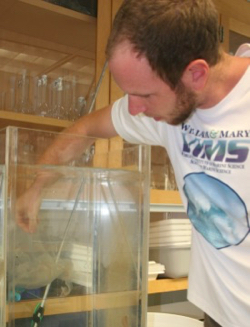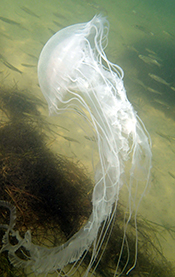
Then-doctoral student Josh Stone tests the buoyancy of a bay nettle in the Zooplankton Ecology laboratory at VIMS. (Photo by D. Malmquist/VIMS)
Scientist at the Virginia Institute of Marine Science (VIMS) have been investigating a Bay-wide scarcity of nettles (aka: jellyfish). The research, published in September in Estuaries and Coasts, serves as the most comprehensive study of Bay jelly populations ever undertaken.
Though they aren’t always well appreciated by humans trying to enjoy the Bay, jellies are a crucial part of the ecosystem. They are a food source for sea turtles and fish, and they themselves feed on a variety of planktonic species.
Joshua Stone used two long-term monitoring surveys to understand jellies and water temperature, salinity, oxygen levels, and other factors, compiling data for five species between 1984 and 2012.
The work was assisted by VIMS professors Deborah Steinberg and Mary Fabrizio, who collected the data from one of the surveys used in Stone’s work. The other survey was collected by the Chesapeake Bay Program.
The team found that one species, Chrysaora chesapeakei, prefers warm, salty water, which helped explained its scarcity this summer, one of the rainiest on record. A species of comb jelly, Mnemiopsis leidyi, was controlled by predation. They found that this species peaked in late June right before their predators became active in July.

The bay nettle Chrysaora chesapeakei. (Photo by J. Lefcheck/VIMS)
Contrary to reports of jellies increasing worldwide, the team found that bay jellies are in a declining pattern. Lower salinity levels in the Bay cause smaller bay jelly populations in the summer. Bay nettles feed on comb jellies, and comb jellies feed on copepods. So when nettle populations decrease and comb jellies increase, copepod populations can decline, which causes problems for fish species that rely on copepods for food.
Researchers are worried that climate change will continue and amplify this change in the food chain. Wetter springs are expected in climate models, which can also cause low-oxygen bottom waters, another contributor to lower reproductive rates in the jellies. Surprisingly, hypoxia could help keep comb jellies from prospering under this scenario, possibly mitigating the effects on copepods. Stone and his team plan to continue their research to better understand the connections between jellyfish populations and the larger Bay ecosystem.
Adapted from an article from William and Mary.
